How hard can it be to build a fence around some shrubs in a field? Not very, you’d think.
You’d be wrong. Or you would be if you did it the way I have. Which definitely isn’t the way to go.
In 2008, I planted a few flowering shrubs along the fence that separates the road from what I call the upper field (because it is higher in elevation than the lower field. Duh.) I wanted to add colour and vitality to an area that offered little visual interest. I planted spring and summer flowering shrubs that deer aren’t meant to like, and shrubs with good autumn colouring. Viburnum, lilac, mock orange, ninebark. Old fashioned shrubs that seemed to suit the character of an old farm field. But I started with an area that was far too small.
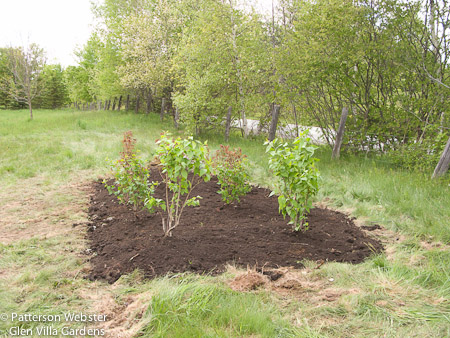 |
| I planted these shrubs in 2008. What was I thinking? |
The shrubs looked pathetic. And they didn’t grow. Every year they tried, and every year the white-tailed deer trimmed every inch of new growth. Despite this, I kept adding more shrubs that supposedly were deer resistant. They weren’t.
 |
|
|
Obviously I needed a fence.
I looked at many types. Split rail fences looked good but they wouldn’t keep the deer out. Ditto for painted wood. Everything I saw was either ineffective, ugly or pretentious, fine for a suburban garden but out of keeping in an old farm field. So I decided to design my own.
I wanted the fence to make a quiet statement, to add interest to an area that felt a bit flat visually. But most of all, it had to work. It had to be strong and sturdy, durable and high enough so the deer couldn’t jump over it. The space between horizontal elements had to be narrow enough so the deer couldn’t stick their noses through. The area inside the fence needed to be thickly planted so they wouldn’t be tempted to jump over.
I considered several options and settled finally on a combination of vertical steel posts and wire cable that runs parallel to the ground. The posts will rust and blend into the landscape, and the cable was almost invisible even when new.
Arranging the posts took some time. I didn’t want a regular rectangle – it felt too much like a prison cell. I didn’t want a half moon coming out from the fencing along the road. In fact, any curving line felt old-fashioned. I tried different patterns and ended up with straight lines that angle in and out, close to and away from the shrubs. For stability, I added a smaller steel post between the uprights, trying it at various heights.
Arranging the posts took some time. I didn’t want a regular rectangle – it felt too much like a prison cell. I didn’t want a half moon coming out from the fencing along the road. In fact, any curving line felt old-fashioned. I tried different patterns and ended up with straight lines that angle in and out, close to and away from the shrubs. For stability, I added a smaller steel post between the uprights, trying it at various heights.
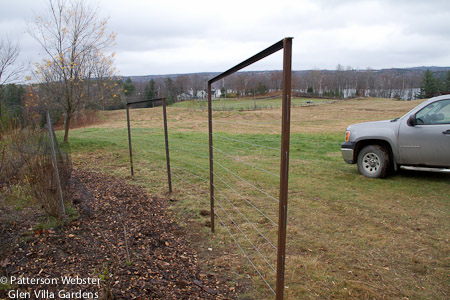 |
| I didn’t like the boxy feel of this variation. The horizontal bar is now 6 inches below the top of the posts. |
After drilling holes at 6 inch intervals for the cable to pass through, Jacques and Ken constructed the fence on site. Getting the posts straight and the cable parallel to the ground took more time than I’d expected. It was particularly difficult because the land slopes downhill fairly sharply. That meant that the crosspieces dropped as the fence went down the hill.
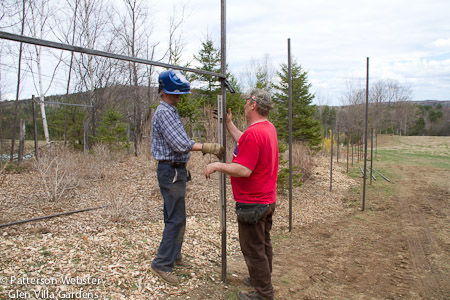 |
| Jacques and Ken check to make sure the vertical posts are absolutely straight. |
We finished the fence this spring. Here’s how part of it looked in May this year. One lilac is blooming but the whole area still looks bare.
 |
| One lilac is blooming. Finally! |
By August, things are looking better. The shrubs are growing and next year they all should flower.
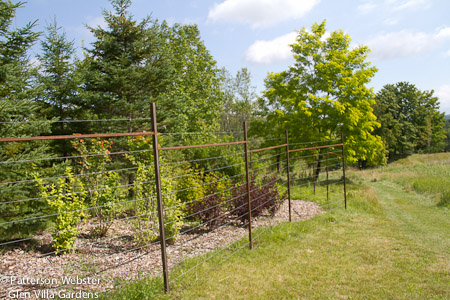 |
| In time the shrubs will grow large enough to eliminate the need for mulch. For now it’s an easy way to keep the weeds down. |
I particularly like the way this shrub is flopping and spreading, creating its own ground cover. I only wish I could remember what it is!
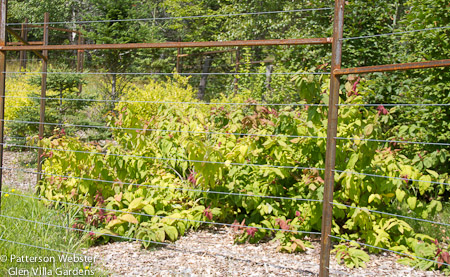 |
| I wish I could remember the name of this sprawling shrub. Is it viburnum ‘Onondaga?’ |
Closer to the house is an area called the Asian meadow. (In the photo below, you can just see some Chinese tiles in the fence that surrounds the picnic belvedere. These help explain the name.) Shrubs there were protected with the same flimsy fencing that I’d used in the upper field. It was unattractive but it did keep the deer away. Sometimes.
I had to search hard to find a photo that showed those fences — clearly I’d avoided including them in any pictures I’d taken. (I really do need to write a post about the lies you can tell with photographs.) I’ve cropped the photo below to emphasize the fences but clearly I took it because of the lupin blooming in the foreground.
 |
| The lupins are lovely, the flimsy fence around the physocarpus ‘Diablo’ is not. |
As soon as we finished the fences in the upper field, I started thinking about fencing for the Asian meadow. I wanted to use the same system of steel posts and wire cable, but the outline needed to change. I decided on a pattern of square boxes, one group of three, two groups of two. Each group includes a section with a gate to give access for maintenance.
 |
| Square boxes are joined by a two-foot section with a gate, allowing access for maintenance. |
There are seven boxes and in the center of each there is a single shrub. The three physocarpus diablo that were growing in the meadow are now installed; thanks to some heavy rain, they haven’t suffered from being transplanted. The same is true for the two small abelia mosanensis planted together in a box, In a fifth square, I left some off-centre liatris that was growing there already.
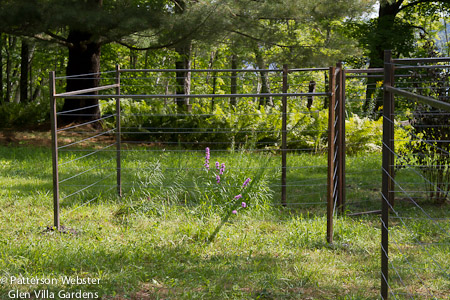 |
| A big fence for a small plant: liatris ‘Kobold.’ |
The liatris doesn’t need protection from the deer but I like the incongruity of a large fence surrounding the small, insignificant plants. I’m not sure how this box will look in the spring and early summer, before the liatris appear. Perhaps I’ll add some bulbs this fall. Maybe allium, maybe fritallaria, maybe eremurus. Maybe even tulips, which I’ve avoided to date because of the squirrels.
There are two more boxes to fill and I haven’t yet decided what to plant in them. The area gets a lot of shade, so sun-loving shrubs won’t work. I have some very small aralia ‘Sun King’ whose citrus leaves would complement the dark leaves of the physocarpus diablo. But aralia doesn’t need protection against the deer – or so the label says.
Based on my experience, that means nothing. Deer will eat anything if they are hungry enough. And deer can’t read.
Still, now that the fence is up, the opportunity to plant something that deer love is overwhelming. Suggestions, anyone?






